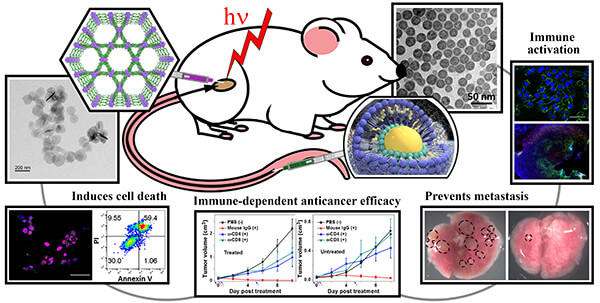University of Chicago — Nanoscale Metal-organic Frameworks for Light Triggered and X-ray Induced Photodynamic Therapy of Head and Neck Cancers
Principal Investigators: Wenbin Lin, Ph.D., and Ralph Weichselbaum, M.D.
Co-Investigators: Stephen Kron, M.D., Ph.D., and Charles Pelizzari, Ph.D.
Project Summary
Head and neck squamous cell carcinoma (HNSCC) is the sixth most common cancer worldwide. The clinically used combination, radiation and chemotherapy, is the most common curative treatment for HNSCC, but causes many undesirable side effects and will incur a progressive resistance. Photodynamic therapy (PDT) is an effective anticancer procedure although its clinical application is limited due to extreme light sensitivity of patients before/after treatment, a suboptimal reactive oxygen species generation efficiency, and shallow tissue penetration (< 1 cm) due to the frequency of light required. On the other hand, nanoparticle-based photosensitizers (PSs) can selectively accumulate in tumors alleviating the light sensitivity issue and more. Near-IR triggered PDT and X-ray induced PDT (X-PDT) have the ability to combine the strength of improved tissue penetration depth of the near-IR and X-ray modalities with the clinical advantages of PDT for deep tumor treatment. We are developing an entirely new class of nanoparticle PSs based on nanoscale metal-organic frameworks (NMOFs) that have the ideal characteristics of tunable chemical compositions, crystalline structures, extremely high porosity, short-term stability, and long-term biodegradability to enable NIR triggered PDT for superficial tumors and X-PDT for deep tumors. This project addresses the unmet needs in developing highly efficient and safe nanoparticle PSs that can have much broader clinical applications for cancer by NIR-triggered PDT or X-PDT.
Specifically, in aim 1 we will optimize NMOF structures, particle sizes, and surface characteristics to achieve NIR-triggered PDT and X-PDT with improved efficiency. Efforts will also be made for scaled-up NMOF synthesis and surface functionalization to achieve long blood circulation times. In aim 2, the NIR-PDT efficacy of NMOFs will be evaluated against multiple HNSCC cell lines in vitro. We will investigate the in vivo toxicity and efficacy of one most potent NMOF identified at cellular level against HNSCC subcutaneous xenograft and orthotopic mouse models. Finally, in aim 3 the X-PDT efficacy of NMOFs will be investigated against HNSCC cells in vitro. For the in vivo studies, we will first evaluate the toxicity of the NMOFs and the X-PDT treatment alone. The in vivo anticancer efficacy will be carried out on both subcutaneous and orthotopic HNSCC mouse models with the two most potent NMOFs identified at the cellular level. We will also apply state-of-the-art small-animal image-guided X-Ray delivery technology to enable image-guided X-PDT, toward translation in clinical radiotherapy.
Project Expertise
The project team includes expertise in nanomaterials, chemistry, radiation oncology, multimodality imaging, and molecular/cell/cancer biology.
